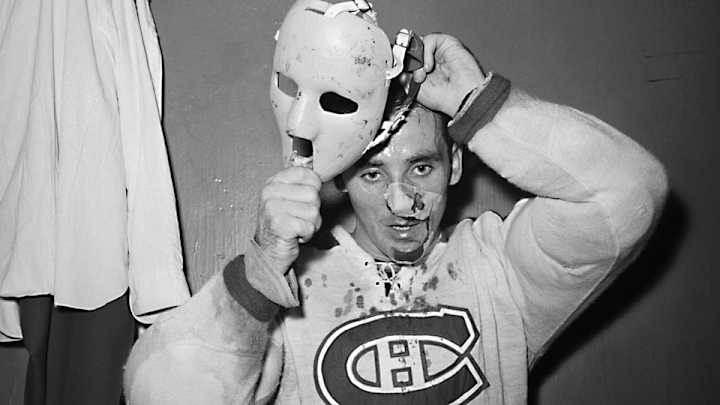Evolution of NHL goalie equipment
Since the NHL's first season in 1917, goalies have been steadily turning into heavily padded high tech monsters.

Modern NHL goaltenders are a far cry from their scantily-padded ancestors, who were required to remain upright while stopping pucks. As the seasons rolled by, rules changed and keepers added to their gear. Their equipment evolved to the point where by the 2000s goalies were being decked out in cutting edge, high tech armor, some of it oversized and sparking a backlash that has led to new restrictions. The photos below trace that evolution.
Georges Vezina
(1917-25) In 1917, goalies in the newly organized NHL were first allowed to drop to the ice to block shots, but their chest and shoulder protection was minimal, usually felt-filled canvas pads. (Ones with metal were not allowed.) Some wore elbow pads on the outside of their sweaters. Leg pads were made of leather that easily became waterlogged. Catching gloves were modified baseball mitts with felt padding inside. Goalie’s originally used the same sticks as skaters but they now had a wider blade to help them stop shots.
George Hainsworth
(1926-37)For the 1925-26 season, the width of leg pads—usually made of horsehide filled with kapok (furniture stuffing) and derived from those used in cricket—was limited to 12 inches. Chest protectors became bigger and thicker, like a baseball catcher’s. Blocker pads were wood frames filled with sponge rubber.
Frank Brimsek
(1938-50)In the mid-‘40s, goalies started using baseball gloves on their catching hands, a trend that began when Emile "the Cat" Francis of the Rangers took the ice with a large first baseman’s glove.
Jacques Plante
(1953-75)When skaters began using curved stick blades, their hard rising shots made goaltending more dangerous. On Nov. 1, 1959, Canadiens goalie Jacques Plante was hit in the face and started using a self-designed fiberglass mask that eventually made facial protection common. (Clint Benedict, in 1930, was first to use a mask, but his leather model was short-lived because it obstructed his view.)
Gerry Cheevers
(1966-82) As masks became popular, some goalies began decorating theirs. The most famous was worn by Boston's Gerry "Cheesy" Cheevers, who painted stitches wherever he had been hit by a shot. Upper body protection now consisted of two pieces for better flexibility. Padding was still stuffed canvas, but goalies began wearing harder caps on their shoulders and elbows.
Ken Dryden
(1971-79) Fiberglass masks were custom fitted according to a goalie's face. Leg pads were also custom made but not all that different than what had been worn since the 1950s. The Cooper GM12 waffle blocker and glove were widely used by NHL keepers.
Billy Smith
(1972-88) Cage masks with steel grills that offered better visibility became popular. Some goalies added a neck protector extension.
Kelly Hrudey
(1984-98) The armor movement took off as available materials became lighter, stronger and waterproof. Goalies started donning customized arm and chest protection that included a nylon suit with thick blocks of foam and plastic, and shoulder flaps to shield the underarm area. Masks were a hybrid of fiberglass and epoxy resin secured to the head by a plate on the back. To gain an edge, some keepers began wearing leg pads that exceeded a width of 12 inches, presaging an era when goaltenders looked for any advantage by inflating their equipment size.
Garth Snow
(1995-06) Goalies filled their nets by donning huge chest protectors and shoulder pads, big loose sweaters, double-wide pants and “thigh rise” leg pads that extended well above the knee to help close off their “five hole.” In 2005, the NHL decided enough was enough and began requiring form-fitting jerseys and pads proportioned to a goalie’s size. Leg pads could be no wider than 11 inches. Blockers were reduced from 16” to 15” and the circumference of catching gloves was shrunk from 48” to 45” to make pucks harder to hold onto and thus create more rebounds.
Ben Bishop
(2012-present) Goalies have come a long way since the days of 5’ 3”, 130-pound keeper Shrimp Worters. Current behemoths like Tampa Bay’s 6’ 7”, 216-pound Ben Bishop are now covered in sophisticated armor of form-fitting Kevlar, plastic, carbon, foam and titanium. Their pants have molded thigh and waist pads. Their leg pads cushion their landings and, when horizontal, lie flush with the ice. But in its constant desire to increase scoring, the NHL reduced the height of leg pads by an average of two inches starting in 2013-14, and more changes are on the way.
Published
